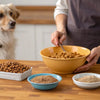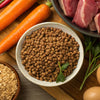How Many Cups of Dog Kibble in a Pound: The Essential Guide for Pet Owners
- Houndsy
Table of Contents
- Introduction
- Understanding Dog Kibble Measurements
- Measuring Dog Kibble: Practical Tips
- Understanding Dog Feeding Guidelines
- Common Questions About Dog Kibble Measurements
- Conclusion
Introduction
Did you know that approximately 59% of dogs in the U.S. are classified as overweight or obese? This staggering statistic emphasizes the importance of proper feeding practices among pet owners. One of the critical aspects of ensuring our furry friends maintain a healthy weight is understanding the relationship between the weight of their food and the volume we serve. The question of how many cups of dog kibble are in a pound is not just a trivial one; it’s essential for maintaining a balanced diet for our pets.
In this blog post, we will delve into the intricacies of measuring dog kibble, including how many cups there are in a pound and how to translate that into your pet’s daily feeding routine. We’ll also discuss how our flagship product, the Houndsy Kibble Dispenser, can enhance your feeding experience, making it convenient, consistent, and visually appealing.
By the end of this article, you will have a thorough understanding of how to measure your dog's food accurately and the impact this has on their health. We invite you to reflect on your own pet feeding routines and explore how Houndsy can elevate that experience.
Understanding Dog Kibble Measurements
The Basics of Weight and Volume
When it comes to dog food, the measurements are often a source of confusion. Dry dog food is typically sold by weight (pounds), while feeding instructions are often given in volume (cups). This can create a disconnect for pet owners trying to determine how much food they should serve.
- Weight vs. Volume: A pound is a unit of weight, while a cup is a measure of volume. This distinction is crucial. For most dry kibble, the general rule of thumb is that there are approximately 4 cups of dog kibble in a pound. This means that if you have a 30-pound bag of kibble, you can expect to have about 120 cups of food.
- Variability in Kibble Size: It is important to note that kibble shapes and sizes can vary significantly between brands. Smaller kibble may take up more volume in a cup than larger kibble, so this measurement can vary slightly based on the specific product you choose.
Why Accurate Measurements Matter
Feeding your dog the right amount of food is essential for their health. Overfeeding can lead to obesity, while underfeeding can cause nutritional deficiencies. Here are some reasons why understanding how many cups are in a pound of kibble is vital:
- Preventing Obesity: As mentioned earlier, a significant percentage of dogs in the U.S. are overweight. Knowing how much you are feeding can help you maintain their ideal weight.
- Nutritional Balance: Each dog has unique dietary needs based on their size, breed, age, and activity level. Accurate measurements allow you to tailor their portions effectively.
- Convenience: Understanding the relationship between weight and volume simplifies the feeding process, making it more manageable for busy pet owners.
Measuring Dog Kibble: Practical Tips
Using a Measuring Cup
To accurately measure your dog's kibble, you should consider using a standard measuring cup. Here are some practical tips for measuring dog food:
- Use a Consistent Cup: Always use the same cup for measuring to maintain consistency. A typical measuring cup holds 8 ounces of volume, but remember that 1 cup of dry dog food weighs approximately 4 ounces.
- Calibrate Your Measurements: If you’re unsure about the measurements, weigh out a few cups of kibble using a kitchen scale. This will help you calibrate your measuring cup to your specific kibble type.
- Consider a Food Scale: For the most accurate measurement, consider investing in a food scale. This allows you to weigh out your dog's food precisely, eliminating any guesswork.
The Role of the Houndsy Kibble Dispenser
At Houndsy, we understand that convenience and functionality are paramount for pet owners. Our Houndsy Kibble Dispenser is designed to simplify the feeding process. With its ergonomic crank and perfect portion control, you can easily dispense the precise amount of kibble without bending over or worrying about mess.
Here are some features that make the Houndsy Kibble Dispenser a must-have for every pet owner:
- Standing Height Crank: No more bending down to scoop kibble! The crank is designed for easy dispensing at a comfortable height.
- Perfect Portions Every Time: With our precise dispensing mechanism, you can ensure that your dog is getting the right amount of food every time.
- Stylish Design: Our mid-century modern design complements your home decor, making pet feeding a visually appealing part of your daily routine.
- Large Storage Capacity: The dispenser holds 25-30 lbs of kibble, making it perfect for households with multiple pets.
You can explore our Houndsy Kibble Dispenser to see how it can fit into your feeding routine.
Understanding Dog Feeding Guidelines
Factors to Consider in Feeding Amounts
When determining the right amount of food for your dog, several factors come into play:
- Dog Size and Breed: Larger breeds need more food than smaller breeds. For example, a Great Dane will require significantly more kibble than a Chihuahua.
- Age: Puppies, adults, and senior dogs have different nutritional needs. Puppies require more calories for growth, while seniors may need fewer calories due to decreased activity levels.
- Activity Level: An active dog will need more food than a sedentary one. Consider your dog's daily activities when determining their portion sizes.
- Health Conditions: Always consult your veterinarian if your dog has health issues that may affect their diet.
Daily Feeding Guidelines
Most dog food brands provide a feeding chart on their packaging, which gives recommendations based on your dog's weight and activity level. Here are some general guidelines:
- Small Dogs (up to 20 lbs): 1/2 to 1 cup per day.
- Medium Dogs (21-50 lbs): 1 to 2 cups per day.
- Large Dogs (51-90 lbs): 2 to 3 cups per day.
- Giant Dogs (over 90 lbs): 3 to 4 cups per day.
It’s essential to monitor your dog’s weight and adjust their food intake accordingly, especially if they are gaining or losing weight.
Common Questions About Dog Kibble Measurements
How Many Cups Are in a 30 lb Bag of Dog Food?
Based on the general measurement of 4 cups per pound, a 30 lb bag of dog food will contain approximately 120 cups of kibble.
How Many Cups Are in a 40 lb Bag of Dog Food?
Similarly, a 40 lb bag of dog food will yield around 160 cups of kibble, making it a great option for pet owners with multiple dogs or larger breeds.
How Much Should I Feed My Dog Daily?
The daily feeding amount can vary based on factors such as age, size, and activity level. It’s best to refer to the specific feeding guidelines on your dog food packaging for precise recommendations.
Conclusion
Understanding how many cups of dog kibble are in a pound is a crucial component of responsible pet ownership. By accurately measuring your dog’s food, you can ensure they receive the right amount of nutrition to maintain a healthy weight and lifestyle.
At Houndsy, we believe that feeding your dog should be a seamless and enjoyable experience. Our Houndsy Kibble Dispenser is designed to make that experience easier and more visually appealing, allowing you to focus on what truly matters—your furry friend.
As you reflect on your pet feeding routines, consider how simplifying the process can enhance both your life and your dog’s well-being.
FAQ
Q: How many cups of dog kibble are in a pound?
A: There are approximately 4 cups of dog kibble in a pound.
Q: How do I measure my dog's food accurately?
A: Use a standard measuring cup and consider weighing the kibble with a kitchen scale to ensure accuracy.
Q: What factors should I consider when determining my dog’s food portion?
A: Consider your dog’s size, age, activity level, and any health issues when determining their portion sizes.
Q: Can the Houndsy Kibble Dispenser help with portion control?
A: Yes, the Houndsy Kibble Dispenser is designed for perfect portion control, making it easier to serve your dog the right amount of food every time.













